HR Analysis and Solutions: Big Bytes Case Study, Leadership Mgmt
VerifiedAdded on 2023/05/28
|18
|4584
|467
Case Study
AI Summary
This case study examines the human resource challenges faced by Big Bytes, a chain store, as reported by Samantha, a general manager. The primary issues identified include a lack of employee motivation, high absenteeism, and the absence of a dedicated HR department. The report delves into the company's internal and external environments to analyze these problems. It proposes short, medium, and long-term recommendations to address the identified issues, such as implementing HR planning, improving recruitment and selection processes, addressing training needs, and managing employee retention. An action plan is developed to facilitate the implementation of these proposals, aiming to improve employee commitment, reduce turnover, and enhance overall organizational performance. The case study highlights the importance of talent management and strategic HR practices in ensuring the success and sustainability of Big Bytes.

BIG BYTES 1
Big Bytes
Name
Course
Tutor
University
City/State
Date
Big Bytes
Name
Course
Tutor
University
City/State
Date
Paraphrase This Document
Need a fresh take? Get an instant paraphrase of this document with our AI Paraphraser
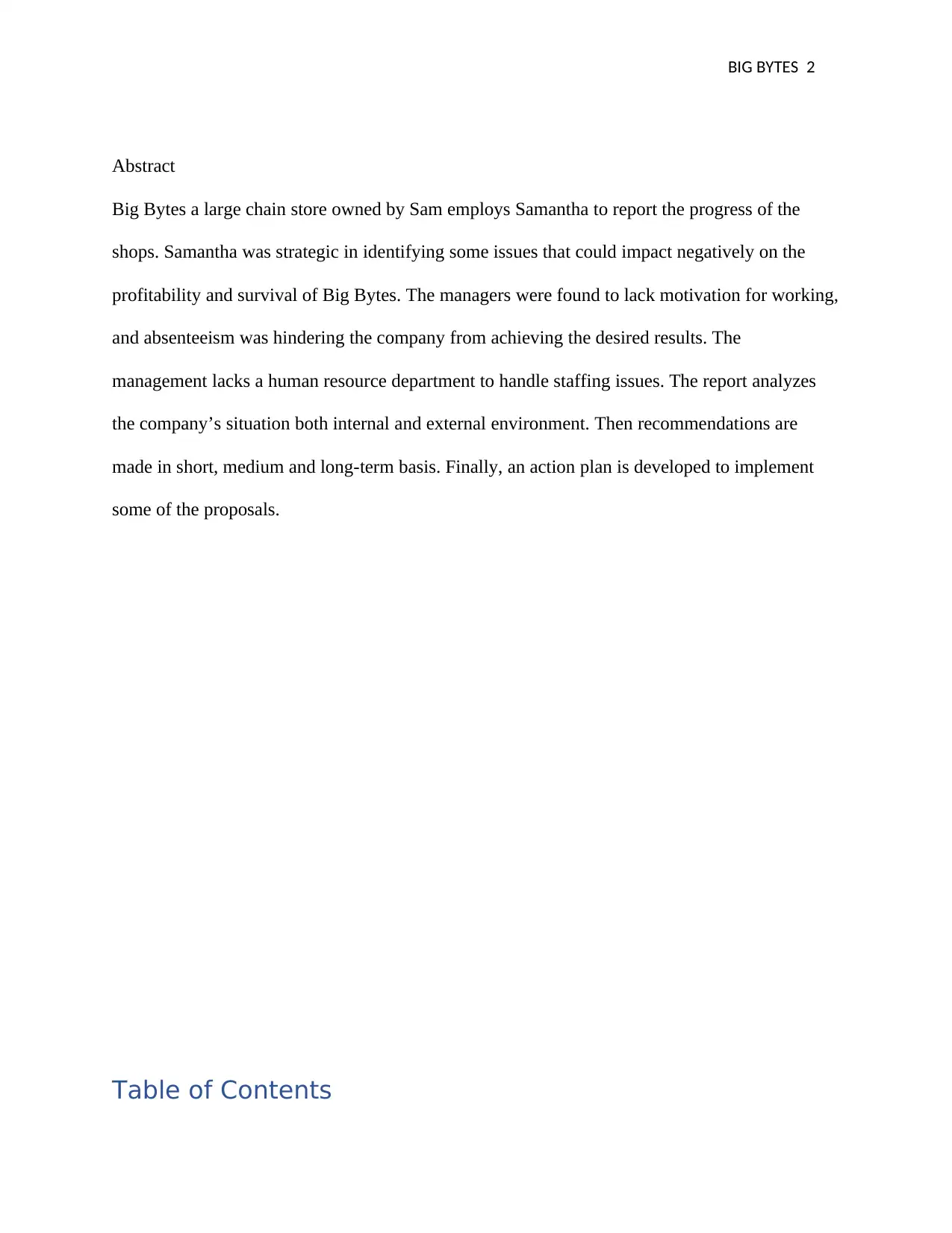
BIG BYTES 2
Abstract
Big Bytes a large chain store owned by Sam employs Samantha to report the progress of the
shops. Samantha was strategic in identifying some issues that could impact negatively on the
profitability and survival of Big Bytes. The managers were found to lack motivation for working,
and absenteeism was hindering the company from achieving the desired results. The
management lacks a human resource department to handle staffing issues. The report analyzes
the company’s situation both internal and external environment. Then recommendations are
made in short, medium and long-term basis. Finally, an action plan is developed to implement
some of the proposals.
Table of Contents
Abstract
Big Bytes a large chain store owned by Sam employs Samantha to report the progress of the
shops. Samantha was strategic in identifying some issues that could impact negatively on the
profitability and survival of Big Bytes. The managers were found to lack motivation for working,
and absenteeism was hindering the company from achieving the desired results. The
management lacks a human resource department to handle staffing issues. The report analyzes
the company’s situation both internal and external environment. Then recommendations are
made in short, medium and long-term basis. Finally, an action plan is developed to implement
some of the proposals.
Table of Contents

BIG BYTES 3
1.0 Introduction...........................................................................................................................................4
2.0 Current issues and the future implications........................................................................................4
3.0 Issues that need to be addressed in the short, medium and long-term............................................5
4.0 HR plan to address future HR needs.................................................................................................9
5.0 Conclusion...........................................................................................................................................13
References.................................................................................................................................................16
1.0 Introduction...........................................................................................................................................4
2.0 Current issues and the future implications........................................................................................4
3.0 Issues that need to be addressed in the short, medium and long-term............................................5
4.0 HR plan to address future HR needs.................................................................................................9
5.0 Conclusion...........................................................................................................................................13
References.................................................................................................................................................16
⊘ This is a preview!⊘
Do you want full access?
Subscribe today to unlock all pages.

Trusted by 1+ million students worldwide
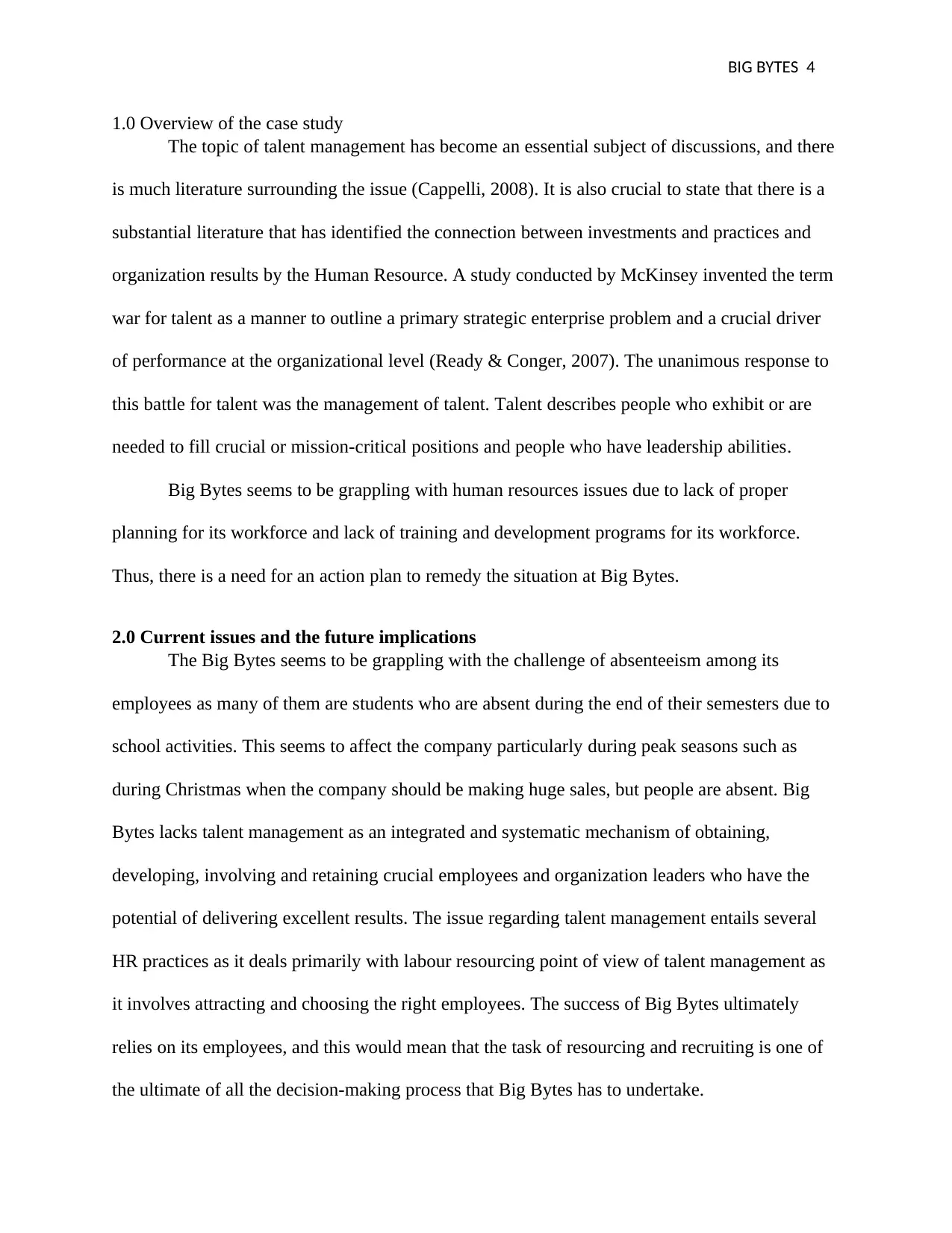
BIG BYTES 4
1.0 Overview of the case study
The topic of talent management has become an essential subject of discussions, and there
is much literature surrounding the issue (Cappelli, 2008). It is also crucial to state that there is a
substantial literature that has identified the connection between investments and practices and
organization results by the Human Resource. A study conducted by McKinsey invented the term
war for talent as a manner to outline a primary strategic enterprise problem and a crucial driver
of performance at the organizational level (Ready & Conger, 2007). The unanimous response to
this battle for talent was the management of talent. Talent describes people who exhibit or are
needed to fill crucial or mission-critical positions and people who have leadership abilities.
Big Bytes seems to be grappling with human resources issues due to lack of proper
planning for its workforce and lack of training and development programs for its workforce.
Thus, there is a need for an action plan to remedy the situation at Big Bytes.
2.0 Current issues and the future implications
The Big Bytes seems to be grappling with the challenge of absenteeism among its
employees as many of them are students who are absent during the end of their semesters due to
school activities. This seems to affect the company particularly during peak seasons such as
during Christmas when the company should be making huge sales, but people are absent. Big
Bytes lacks talent management as an integrated and systematic mechanism of obtaining,
developing, involving and retaining crucial employees and organization leaders who have the
potential of delivering excellent results. The issue regarding talent management entails several
HR practices as it deals primarily with labour resourcing point of view of talent management as
it involves attracting and choosing the right employees. The success of Big Bytes ultimately
relies on its employees, and this would mean that the task of resourcing and recruiting is one of
the ultimate of all the decision-making process that Big Bytes has to undertake.
1.0 Overview of the case study
The topic of talent management has become an essential subject of discussions, and there
is much literature surrounding the issue (Cappelli, 2008). It is also crucial to state that there is a
substantial literature that has identified the connection between investments and practices and
organization results by the Human Resource. A study conducted by McKinsey invented the term
war for talent as a manner to outline a primary strategic enterprise problem and a crucial driver
of performance at the organizational level (Ready & Conger, 2007). The unanimous response to
this battle for talent was the management of talent. Talent describes people who exhibit or are
needed to fill crucial or mission-critical positions and people who have leadership abilities.
Big Bytes seems to be grappling with human resources issues due to lack of proper
planning for its workforce and lack of training and development programs for its workforce.
Thus, there is a need for an action plan to remedy the situation at Big Bytes.
2.0 Current issues and the future implications
The Big Bytes seems to be grappling with the challenge of absenteeism among its
employees as many of them are students who are absent during the end of their semesters due to
school activities. This seems to affect the company particularly during peak seasons such as
during Christmas when the company should be making huge sales, but people are absent. Big
Bytes lacks talent management as an integrated and systematic mechanism of obtaining,
developing, involving and retaining crucial employees and organization leaders who have the
potential of delivering excellent results. The issue regarding talent management entails several
HR practices as it deals primarily with labour resourcing point of view of talent management as
it involves attracting and choosing the right employees. The success of Big Bytes ultimately
relies on its employees, and this would mean that the task of resourcing and recruiting is one of
the ultimate of all the decision-making process that Big Bytes has to undertake.
Paraphrase This Document
Need a fresh take? Get an instant paraphrase of this document with our AI Paraphraser
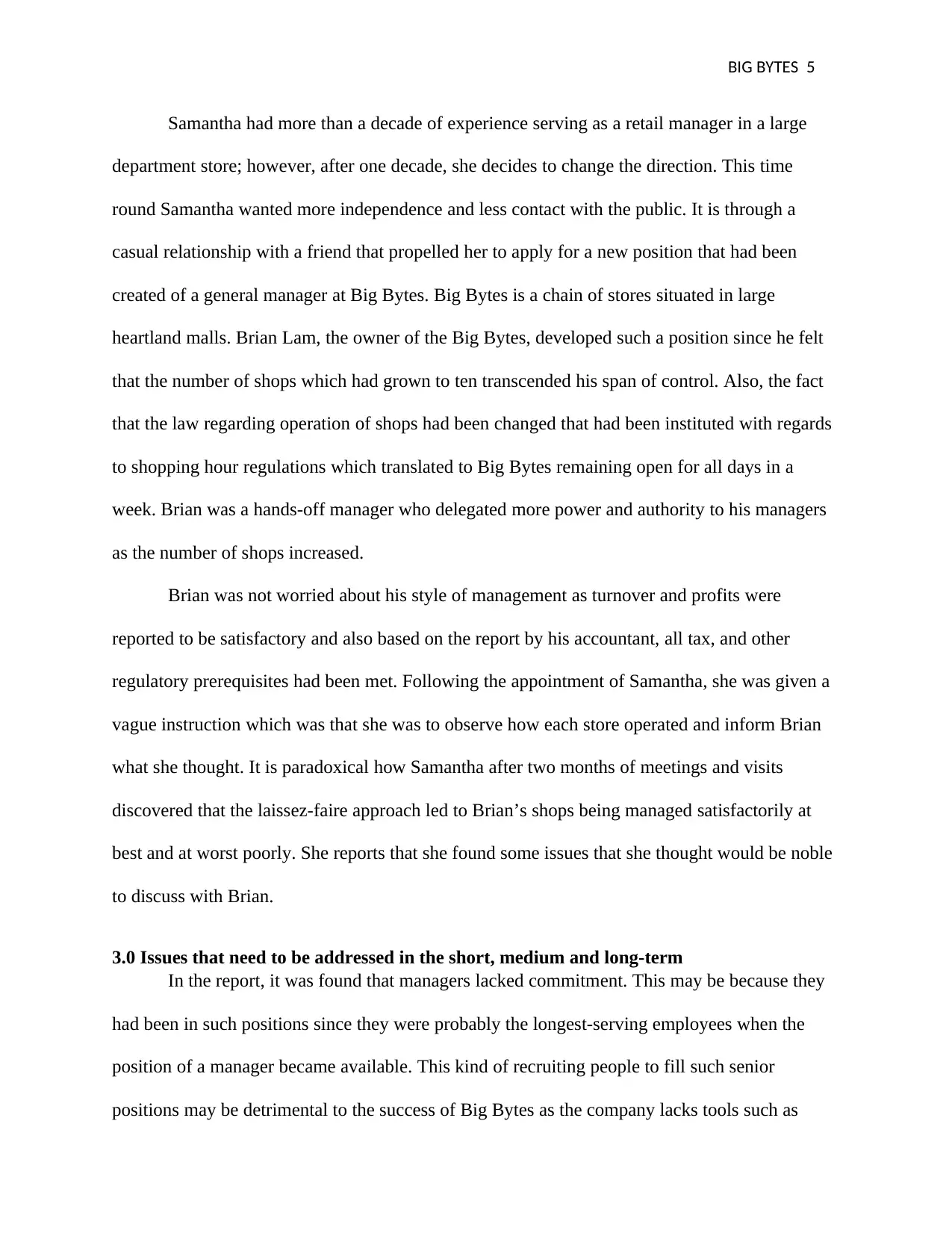
BIG BYTES 5
Samantha had more than a decade of experience serving as a retail manager in a large
department store; however, after one decade, she decides to change the direction. This time
round Samantha wanted more independence and less contact with the public. It is through a
casual relationship with a friend that propelled her to apply for a new position that had been
created of a general manager at Big Bytes. Big Bytes is a chain of stores situated in large
heartland malls. Brian Lam, the owner of the Big Bytes, developed such a position since he felt
that the number of shops which had grown to ten transcended his span of control. Also, the fact
that the law regarding operation of shops had been changed that had been instituted with regards
to shopping hour regulations which translated to Big Bytes remaining open for all days in a
week. Brian was a hands-off manager who delegated more power and authority to his managers
as the number of shops increased.
Brian was not worried about his style of management as turnover and profits were
reported to be satisfactory and also based on the report by his accountant, all tax, and other
regulatory prerequisites had been met. Following the appointment of Samantha, she was given a
vague instruction which was that she was to observe how each store operated and inform Brian
what she thought. It is paradoxical how Samantha after two months of meetings and visits
discovered that the laissez-faire approach led to Brian’s shops being managed satisfactorily at
best and at worst poorly. She reports that she found some issues that she thought would be noble
to discuss with Brian.
3.0 Issues that need to be addressed in the short, medium and long-term
In the report, it was found that managers lacked commitment. This may be because they
had been in such positions since they were probably the longest-serving employees when the
position of a manager became available. This kind of recruiting people to fill such senior
positions may be detrimental to the success of Big Bytes as the company lacks tools such as
Samantha had more than a decade of experience serving as a retail manager in a large
department store; however, after one decade, she decides to change the direction. This time
round Samantha wanted more independence and less contact with the public. It is through a
casual relationship with a friend that propelled her to apply for a new position that had been
created of a general manager at Big Bytes. Big Bytes is a chain of stores situated in large
heartland malls. Brian Lam, the owner of the Big Bytes, developed such a position since he felt
that the number of shops which had grown to ten transcended his span of control. Also, the fact
that the law regarding operation of shops had been changed that had been instituted with regards
to shopping hour regulations which translated to Big Bytes remaining open for all days in a
week. Brian was a hands-off manager who delegated more power and authority to his managers
as the number of shops increased.
Brian was not worried about his style of management as turnover and profits were
reported to be satisfactory and also based on the report by his accountant, all tax, and other
regulatory prerequisites had been met. Following the appointment of Samantha, she was given a
vague instruction which was that she was to observe how each store operated and inform Brian
what she thought. It is paradoxical how Samantha after two months of meetings and visits
discovered that the laissez-faire approach led to Brian’s shops being managed satisfactorily at
best and at worst poorly. She reports that she found some issues that she thought would be noble
to discuss with Brian.
3.0 Issues that need to be addressed in the short, medium and long-term
In the report, it was found that managers lacked commitment. This may be because they
had been in such positions since they were probably the longest-serving employees when the
position of a manager became available. This kind of recruiting people to fill such senior
positions may be detrimental to the success of Big Bytes as the company lacks tools such as
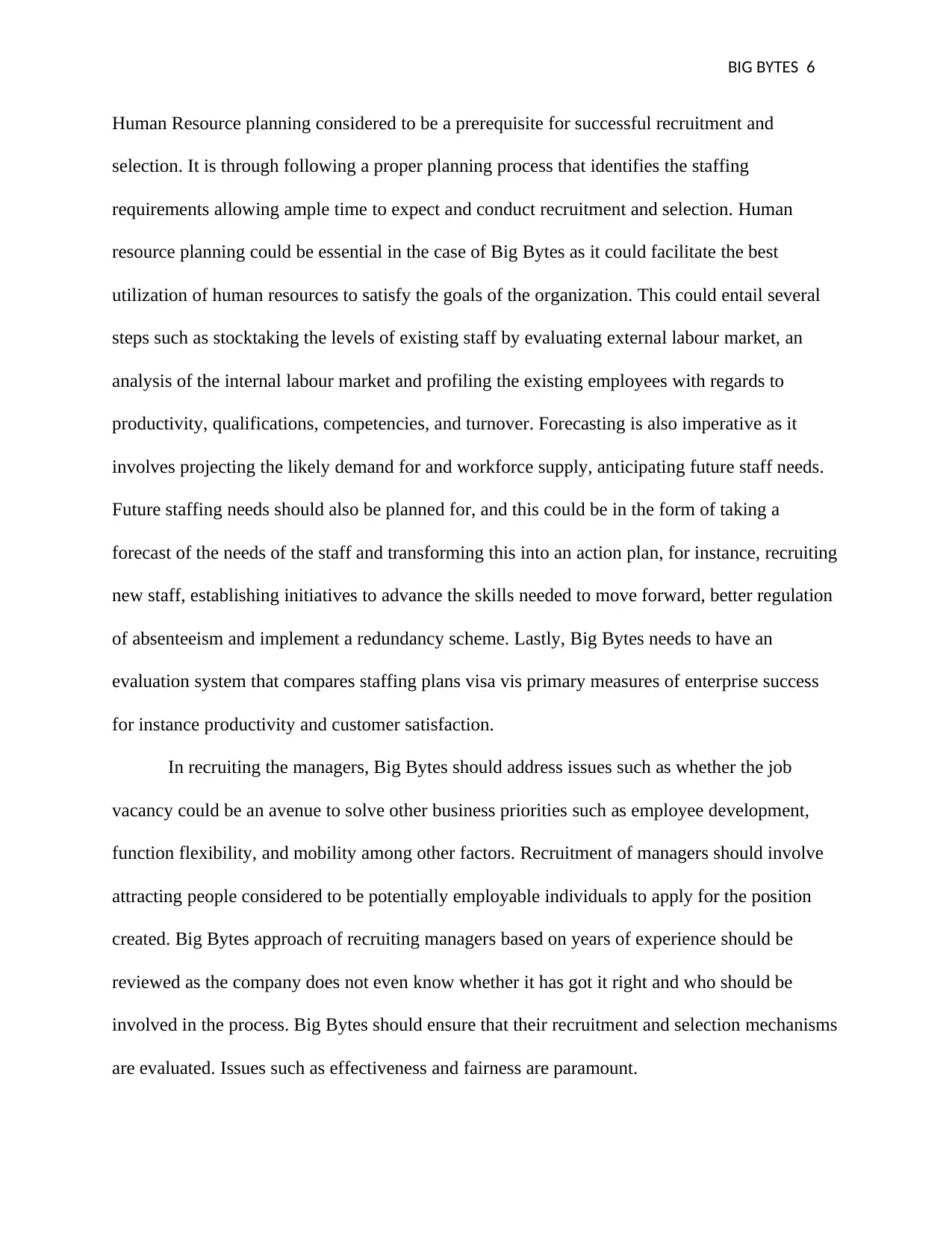
BIG BYTES 6
Human Resource planning considered to be a prerequisite for successful recruitment and
selection. It is through following a proper planning process that identifies the staffing
requirements allowing ample time to expect and conduct recruitment and selection. Human
resource planning could be essential in the case of Big Bytes as it could facilitate the best
utilization of human resources to satisfy the goals of the organization. This could entail several
steps such as stocktaking the levels of existing staff by evaluating external labour market, an
analysis of the internal labour market and profiling the existing employees with regards to
productivity, qualifications, competencies, and turnover. Forecasting is also imperative as it
involves projecting the likely demand for and workforce supply, anticipating future staff needs.
Future staffing needs should also be planned for, and this could be in the form of taking a
forecast of the needs of the staff and transforming this into an action plan, for instance, recruiting
new staff, establishing initiatives to advance the skills needed to move forward, better regulation
of absenteeism and implement a redundancy scheme. Lastly, Big Bytes needs to have an
evaluation system that compares staffing plans visa vis primary measures of enterprise success
for instance productivity and customer satisfaction.
In recruiting the managers, Big Bytes should address issues such as whether the job
vacancy could be an avenue to solve other business priorities such as employee development,
function flexibility, and mobility among other factors. Recruitment of managers should involve
attracting people considered to be potentially employable individuals to apply for the position
created. Big Bytes approach of recruiting managers based on years of experience should be
reviewed as the company does not even know whether it has got it right and who should be
involved in the process. Big Bytes should ensure that their recruitment and selection mechanisms
are evaluated. Issues such as effectiveness and fairness are paramount.
Human Resource planning considered to be a prerequisite for successful recruitment and
selection. It is through following a proper planning process that identifies the staffing
requirements allowing ample time to expect and conduct recruitment and selection. Human
resource planning could be essential in the case of Big Bytes as it could facilitate the best
utilization of human resources to satisfy the goals of the organization. This could entail several
steps such as stocktaking the levels of existing staff by evaluating external labour market, an
analysis of the internal labour market and profiling the existing employees with regards to
productivity, qualifications, competencies, and turnover. Forecasting is also imperative as it
involves projecting the likely demand for and workforce supply, anticipating future staff needs.
Future staffing needs should also be planned for, and this could be in the form of taking a
forecast of the needs of the staff and transforming this into an action plan, for instance, recruiting
new staff, establishing initiatives to advance the skills needed to move forward, better regulation
of absenteeism and implement a redundancy scheme. Lastly, Big Bytes needs to have an
evaluation system that compares staffing plans visa vis primary measures of enterprise success
for instance productivity and customer satisfaction.
In recruiting the managers, Big Bytes should address issues such as whether the job
vacancy could be an avenue to solve other business priorities such as employee development,
function flexibility, and mobility among other factors. Recruitment of managers should involve
attracting people considered to be potentially employable individuals to apply for the position
created. Big Bytes approach of recruiting managers based on years of experience should be
reviewed as the company does not even know whether it has got it right and who should be
involved in the process. Big Bytes should ensure that their recruitment and selection mechanisms
are evaluated. Issues such as effectiveness and fairness are paramount.
⊘ This is a preview!⊘
Do you want full access?
Subscribe today to unlock all pages.

Trusted by 1+ million students worldwide
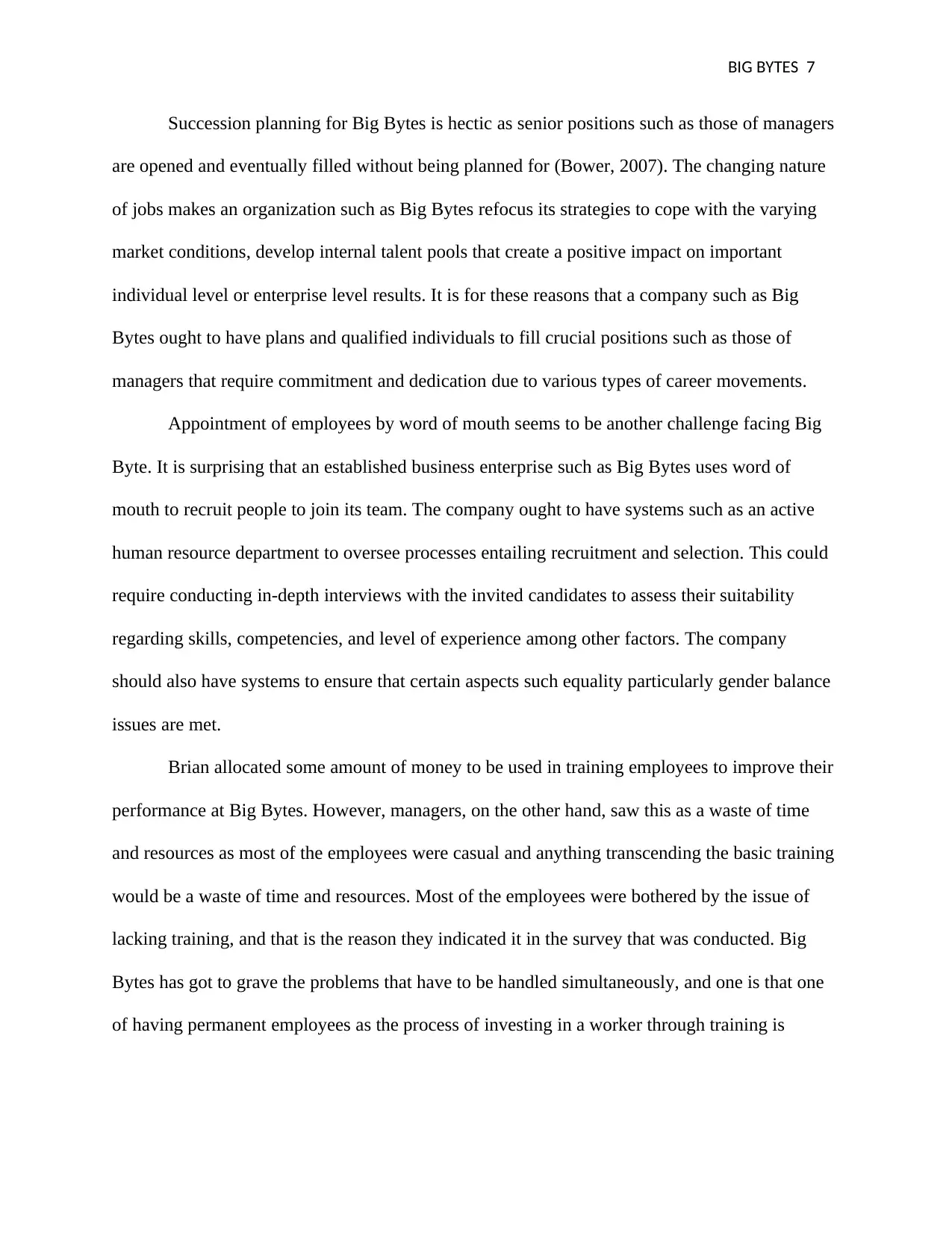
BIG BYTES 7
Succession planning for Big Bytes is hectic as senior positions such as those of managers
are opened and eventually filled without being planned for (Bower, 2007). The changing nature
of jobs makes an organization such as Big Bytes refocus its strategies to cope with the varying
market conditions, develop internal talent pools that create a positive impact on important
individual level or enterprise level results. It is for these reasons that a company such as Big
Bytes ought to have plans and qualified individuals to fill crucial positions such as those of
managers that require commitment and dedication due to various types of career movements.
Appointment of employees by word of mouth seems to be another challenge facing Big
Byte. It is surprising that an established business enterprise such as Big Bytes uses word of
mouth to recruit people to join its team. The company ought to have systems such as an active
human resource department to oversee processes entailing recruitment and selection. This could
require conducting in-depth interviews with the invited candidates to assess their suitability
regarding skills, competencies, and level of experience among other factors. The company
should also have systems to ensure that certain aspects such equality particularly gender balance
issues are met.
Brian allocated some amount of money to be used in training employees to improve their
performance at Big Bytes. However, managers, on the other hand, saw this as a waste of time
and resources as most of the employees were casual and anything transcending the basic training
would be a waste of time and resources. Most of the employees were bothered by the issue of
lacking training, and that is the reason they indicated it in the survey that was conducted. Big
Bytes has got to grave the problems that have to be handled simultaneously, and one is that one
of having permanent employees as the process of investing in a worker through training is
Succession planning for Big Bytes is hectic as senior positions such as those of managers
are opened and eventually filled without being planned for (Bower, 2007). The changing nature
of jobs makes an organization such as Big Bytes refocus its strategies to cope with the varying
market conditions, develop internal talent pools that create a positive impact on important
individual level or enterprise level results. It is for these reasons that a company such as Big
Bytes ought to have plans and qualified individuals to fill crucial positions such as those of
managers that require commitment and dedication due to various types of career movements.
Appointment of employees by word of mouth seems to be another challenge facing Big
Byte. It is surprising that an established business enterprise such as Big Bytes uses word of
mouth to recruit people to join its team. The company ought to have systems such as an active
human resource department to oversee processes entailing recruitment and selection. This could
require conducting in-depth interviews with the invited candidates to assess their suitability
regarding skills, competencies, and level of experience among other factors. The company
should also have systems to ensure that certain aspects such equality particularly gender balance
issues are met.
Brian allocated some amount of money to be used in training employees to improve their
performance at Big Bytes. However, managers, on the other hand, saw this as a waste of time
and resources as most of the employees were casual and anything transcending the basic training
would be a waste of time and resources. Most of the employees were bothered by the issue of
lacking training, and that is the reason they indicated it in the survey that was conducted. Big
Bytes has got to grave the problems that have to be handled simultaneously, and one is that one
of having permanent employees as the process of investing in a worker through training is
Paraphrase This Document
Need a fresh take? Get an instant paraphrase of this document with our AI Paraphraser
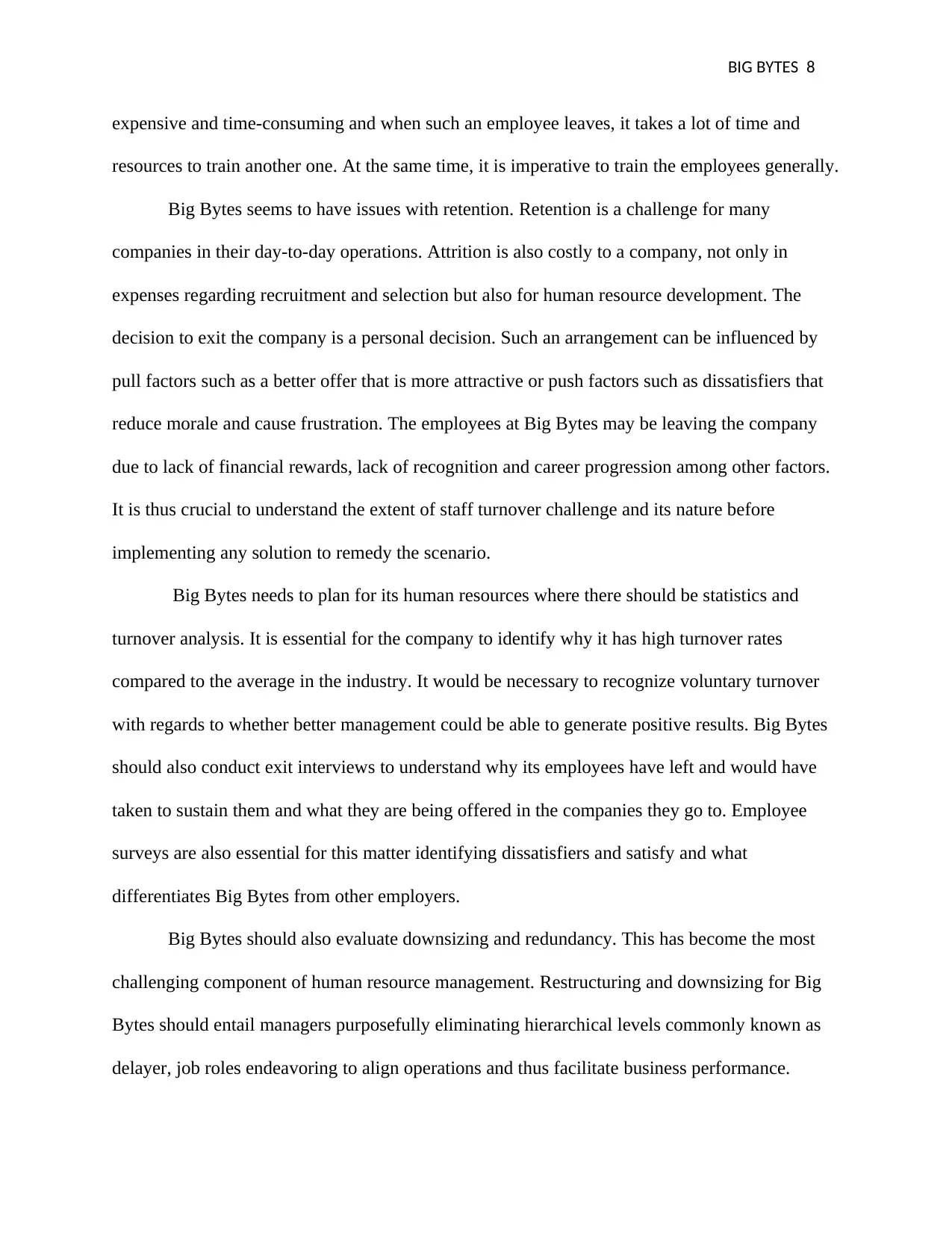
BIG BYTES 8
expensive and time-consuming and when such an employee leaves, it takes a lot of time and
resources to train another one. At the same time, it is imperative to train the employees generally.
Big Bytes seems to have issues with retention. Retention is a challenge for many
companies in their day-to-day operations. Attrition is also costly to a company, not only in
expenses regarding recruitment and selection but also for human resource development. The
decision to exit the company is a personal decision. Such an arrangement can be influenced by
pull factors such as a better offer that is more attractive or push factors such as dissatisfiers that
reduce morale and cause frustration. The employees at Big Bytes may be leaving the company
due to lack of financial rewards, lack of recognition and career progression among other factors.
It is thus crucial to understand the extent of staff turnover challenge and its nature before
implementing any solution to remedy the scenario.
Big Bytes needs to plan for its human resources where there should be statistics and
turnover analysis. It is essential for the company to identify why it has high turnover rates
compared to the average in the industry. It would be necessary to recognize voluntary turnover
with regards to whether better management could be able to generate positive results. Big Bytes
should also conduct exit interviews to understand why its employees have left and would have
taken to sustain them and what they are being offered in the companies they go to. Employee
surveys are also essential for this matter identifying dissatisfiers and satisfy and what
differentiates Big Bytes from other employers.
Big Bytes should also evaluate downsizing and redundancy. This has become the most
challenging component of human resource management. Restructuring and downsizing for Big
Bytes should entail managers purposefully eliminating hierarchical levels commonly known as
delayer, job roles endeavoring to align operations and thus facilitate business performance.
expensive and time-consuming and when such an employee leaves, it takes a lot of time and
resources to train another one. At the same time, it is imperative to train the employees generally.
Big Bytes seems to have issues with retention. Retention is a challenge for many
companies in their day-to-day operations. Attrition is also costly to a company, not only in
expenses regarding recruitment and selection but also for human resource development. The
decision to exit the company is a personal decision. Such an arrangement can be influenced by
pull factors such as a better offer that is more attractive or push factors such as dissatisfiers that
reduce morale and cause frustration. The employees at Big Bytes may be leaving the company
due to lack of financial rewards, lack of recognition and career progression among other factors.
It is thus crucial to understand the extent of staff turnover challenge and its nature before
implementing any solution to remedy the scenario.
Big Bytes needs to plan for its human resources where there should be statistics and
turnover analysis. It is essential for the company to identify why it has high turnover rates
compared to the average in the industry. It would be necessary to recognize voluntary turnover
with regards to whether better management could be able to generate positive results. Big Bytes
should also conduct exit interviews to understand why its employees have left and would have
taken to sustain them and what they are being offered in the companies they go to. Employee
surveys are also essential for this matter identifying dissatisfiers and satisfy and what
differentiates Big Bytes from other employers.
Big Bytes should also evaluate downsizing and redundancy. This has become the most
challenging component of human resource management. Restructuring and downsizing for Big
Bytes should entail managers purposefully eliminating hierarchical levels commonly known as
delayer, job roles endeavoring to align operations and thus facilitate business performance.
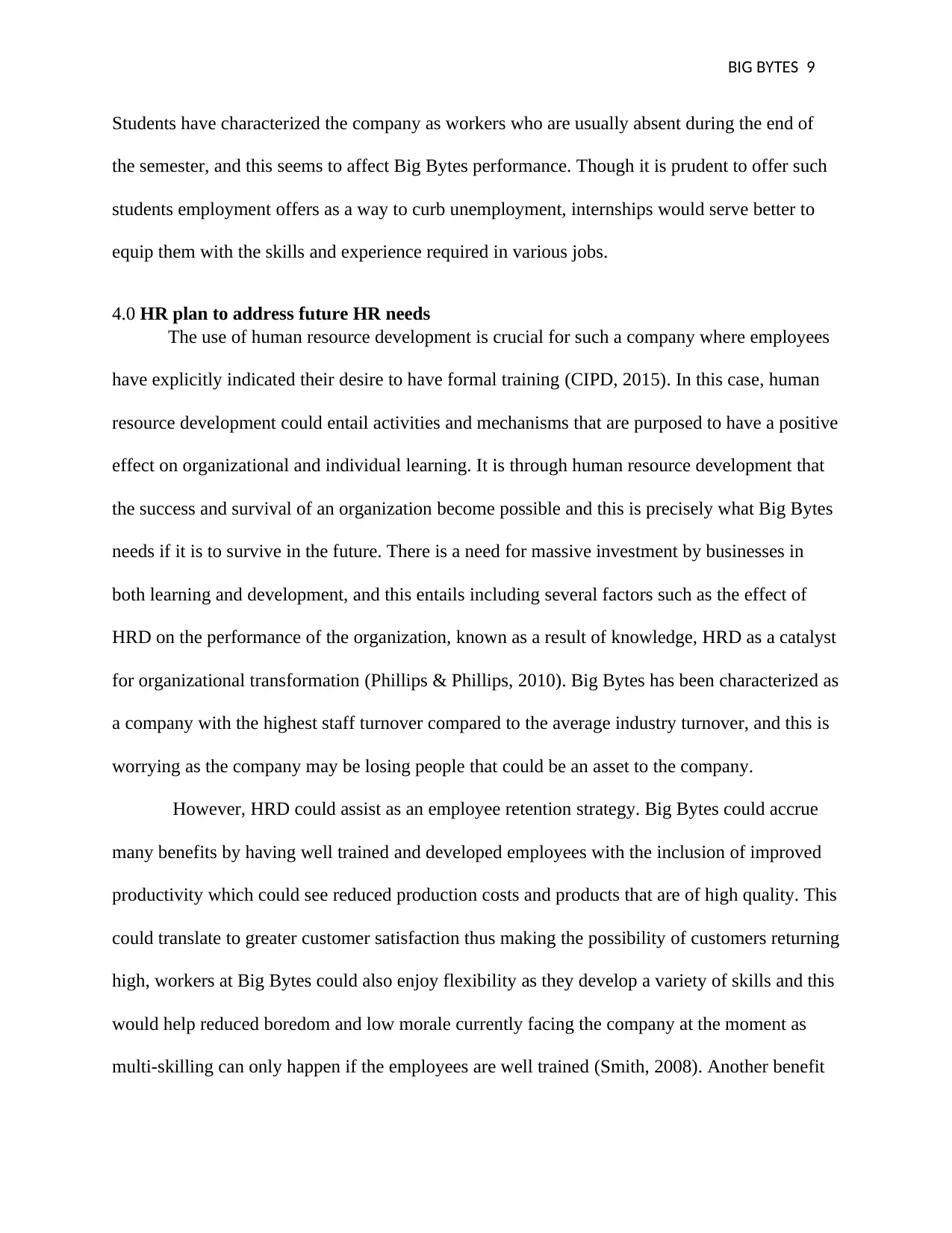
BIG BYTES 9
Students have characterized the company as workers who are usually absent during the end of
the semester, and this seems to affect Big Bytes performance. Though it is prudent to offer such
students employment offers as a way to curb unemployment, internships would serve better to
equip them with the skills and experience required in various jobs.
4.0 HR plan to address future HR needs
The use of human resource development is crucial for such a company where employees
have explicitly indicated their desire to have formal training (CIPD, 2015). In this case, human
resource development could entail activities and mechanisms that are purposed to have a positive
effect on organizational and individual learning. It is through human resource development that
the success and survival of an organization become possible and this is precisely what Big Bytes
needs if it is to survive in the future. There is a need for massive investment by businesses in
both learning and development, and this entails including several factors such as the effect of
HRD on the performance of the organization, known as a result of knowledge, HRD as a catalyst
for organizational transformation (Phillips & Phillips, 2010). Big Bytes has been characterized as
a company with the highest staff turnover compared to the average industry turnover, and this is
worrying as the company may be losing people that could be an asset to the company.
However, HRD could assist as an employee retention strategy. Big Bytes could accrue
many benefits by having well trained and developed employees with the inclusion of improved
productivity which could see reduced production costs and products that are of high quality. This
could translate to greater customer satisfaction thus making the possibility of customers returning
high, workers at Big Bytes could also enjoy flexibility as they develop a variety of skills and this
would help reduced boredom and low morale currently facing the company at the moment as
multi-skilling can only happen if the employees are well trained (Smith, 2008). Another benefit
Students have characterized the company as workers who are usually absent during the end of
the semester, and this seems to affect Big Bytes performance. Though it is prudent to offer such
students employment offers as a way to curb unemployment, internships would serve better to
equip them with the skills and experience required in various jobs.
4.0 HR plan to address future HR needs
The use of human resource development is crucial for such a company where employees
have explicitly indicated their desire to have formal training (CIPD, 2015). In this case, human
resource development could entail activities and mechanisms that are purposed to have a positive
effect on organizational and individual learning. It is through human resource development that
the success and survival of an organization become possible and this is precisely what Big Bytes
needs if it is to survive in the future. There is a need for massive investment by businesses in
both learning and development, and this entails including several factors such as the effect of
HRD on the performance of the organization, known as a result of knowledge, HRD as a catalyst
for organizational transformation (Phillips & Phillips, 2010). Big Bytes has been characterized as
a company with the highest staff turnover compared to the average industry turnover, and this is
worrying as the company may be losing people that could be an asset to the company.
However, HRD could assist as an employee retention strategy. Big Bytes could accrue
many benefits by having well trained and developed employees with the inclusion of improved
productivity which could see reduced production costs and products that are of high quality. This
could translate to greater customer satisfaction thus making the possibility of customers returning
high, workers at Big Bytes could also enjoy flexibility as they develop a variety of skills and this
would help reduced boredom and low morale currently facing the company at the moment as
multi-skilling can only happen if the employees are well trained (Smith, 2008). Another benefit
⊘ This is a preview!⊘
Do you want full access?
Subscribe today to unlock all pages.

Trusted by 1+ million students worldwide
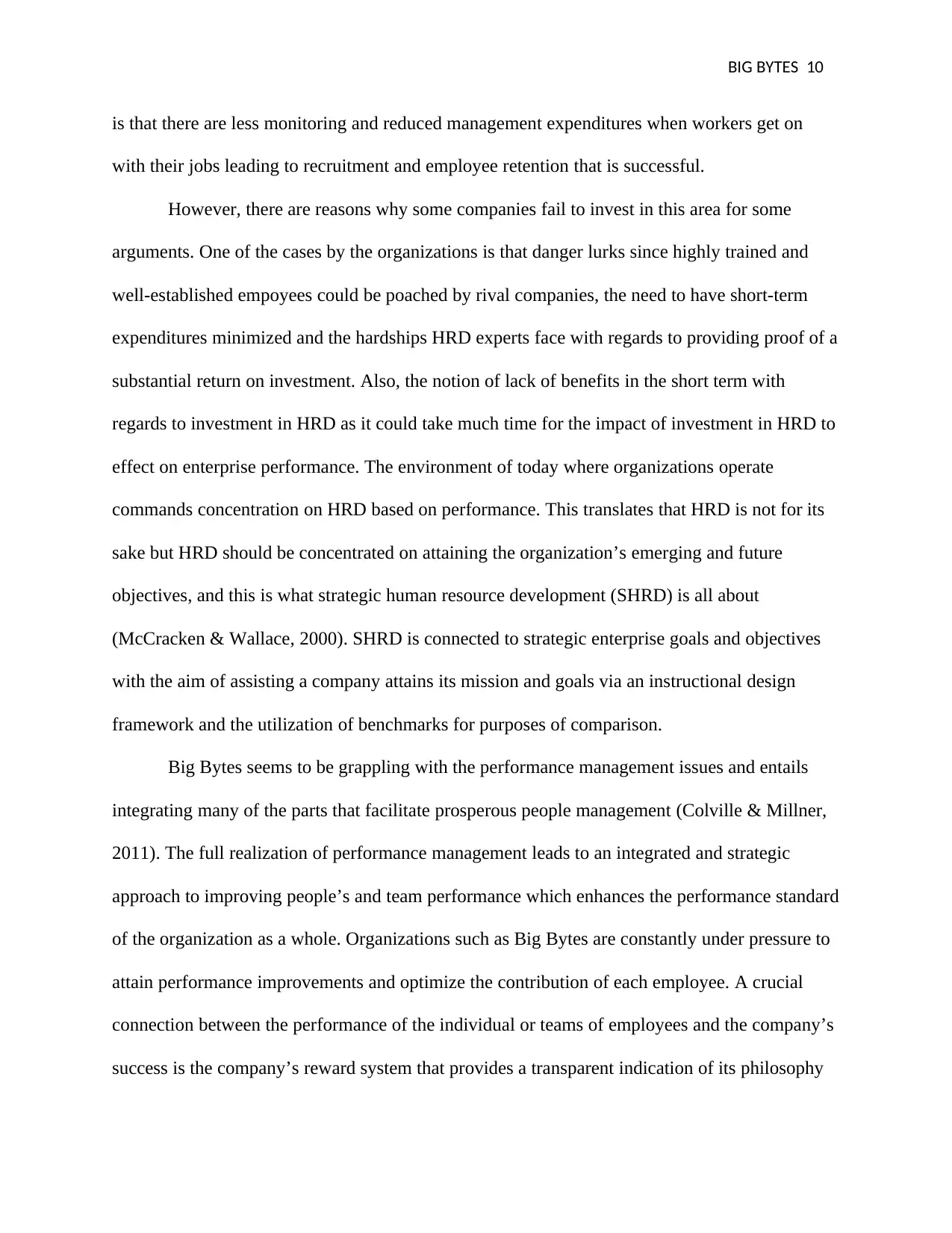
BIG BYTES 10
is that there are less monitoring and reduced management expenditures when workers get on
with their jobs leading to recruitment and employee retention that is successful.
However, there are reasons why some companies fail to invest in this area for some
arguments. One of the cases by the organizations is that danger lurks since highly trained and
well-established empoyees could be poached by rival companies, the need to have short-term
expenditures minimized and the hardships HRD experts face with regards to providing proof of a
substantial return on investment. Also, the notion of lack of benefits in the short term with
regards to investment in HRD as it could take much time for the impact of investment in HRD to
effect on enterprise performance. The environment of today where organizations operate
commands concentration on HRD based on performance. This translates that HRD is not for its
sake but HRD should be concentrated on attaining the organization’s emerging and future
objectives, and this is what strategic human resource development (SHRD) is all about
(McCracken & Wallace, 2000). SHRD is connected to strategic enterprise goals and objectives
with the aim of assisting a company attains its mission and goals via an instructional design
framework and the utilization of benchmarks for purposes of comparison.
Big Bytes seems to be grappling with the performance management issues and entails
integrating many of the parts that facilitate prosperous people management (Colville & Millner,
2011). The full realization of performance management leads to an integrated and strategic
approach to improving people’s and team performance which enhances the performance standard
of the organization as a whole. Organizations such as Big Bytes are constantly under pressure to
attain performance improvements and optimize the contribution of each employee. A crucial
connection between the performance of the individual or teams of employees and the company’s
success is the company’s reward system that provides a transparent indication of its philosophy
is that there are less monitoring and reduced management expenditures when workers get on
with their jobs leading to recruitment and employee retention that is successful.
However, there are reasons why some companies fail to invest in this area for some
arguments. One of the cases by the organizations is that danger lurks since highly trained and
well-established empoyees could be poached by rival companies, the need to have short-term
expenditures minimized and the hardships HRD experts face with regards to providing proof of a
substantial return on investment. Also, the notion of lack of benefits in the short term with
regards to investment in HRD as it could take much time for the impact of investment in HRD to
effect on enterprise performance. The environment of today where organizations operate
commands concentration on HRD based on performance. This translates that HRD is not for its
sake but HRD should be concentrated on attaining the organization’s emerging and future
objectives, and this is what strategic human resource development (SHRD) is all about
(McCracken & Wallace, 2000). SHRD is connected to strategic enterprise goals and objectives
with the aim of assisting a company attains its mission and goals via an instructional design
framework and the utilization of benchmarks for purposes of comparison.
Big Bytes seems to be grappling with the performance management issues and entails
integrating many of the parts that facilitate prosperous people management (Colville & Millner,
2011). The full realization of performance management leads to an integrated and strategic
approach to improving people’s and team performance which enhances the performance standard
of the organization as a whole. Organizations such as Big Bytes are constantly under pressure to
attain performance improvements and optimize the contribution of each employee. A crucial
connection between the performance of the individual or teams of employees and the company’s
success is the company’s reward system that provides a transparent indication of its philosophy
Paraphrase This Document
Need a fresh take? Get an instant paraphrase of this document with our AI Paraphraser
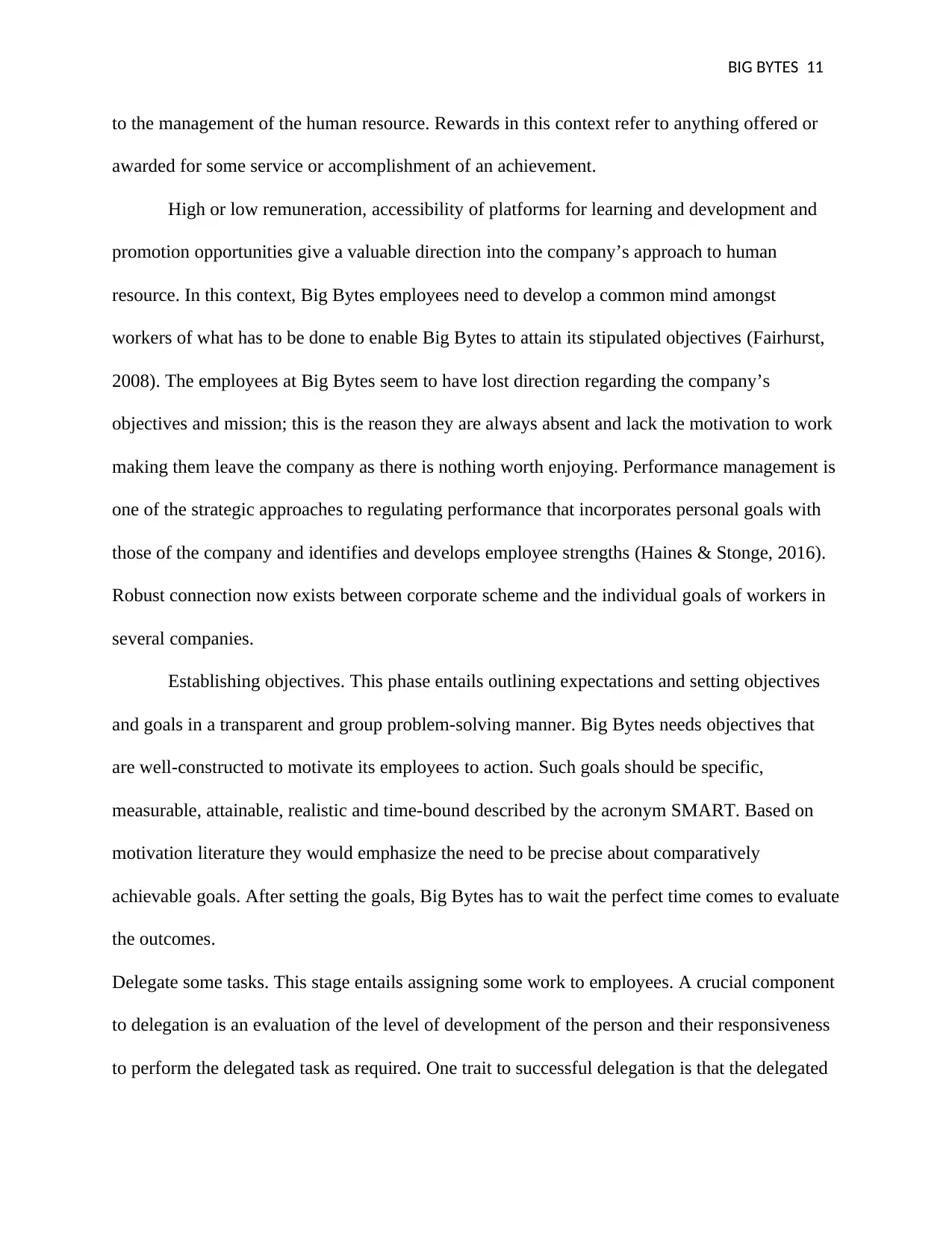
BIG BYTES 11
to the management of the human resource. Rewards in this context refer to anything offered or
awarded for some service or accomplishment of an achievement.
High or low remuneration, accessibility of platforms for learning and development and
promotion opportunities give a valuable direction into the company’s approach to human
resource. In this context, Big Bytes employees need to develop a common mind amongst
workers of what has to be done to enable Big Bytes to attain its stipulated objectives (Fairhurst,
2008). The employees at Big Bytes seem to have lost direction regarding the company’s
objectives and mission; this is the reason they are always absent and lack the motivation to work
making them leave the company as there is nothing worth enjoying. Performance management is
one of the strategic approaches to regulating performance that incorporates personal goals with
those of the company and identifies and develops employee strengths (Haines & Stonge, 2016).
Robust connection now exists between corporate scheme and the individual goals of workers in
several companies.
Establishing objectives. This phase entails outlining expectations and setting objectives
and goals in a transparent and group problem-solving manner. Big Bytes needs objectives that
are well-constructed to motivate its employees to action. Such goals should be specific,
measurable, attainable, realistic and time-bound described by the acronym SMART. Based on
motivation literature they would emphasize the need to be precise about comparatively
achievable goals. After setting the goals, Big Bytes has to wait the perfect time comes to evaluate
the outcomes.
Delegate some tasks. This stage entails assigning some work to employees. A crucial component
to delegation is an evaluation of the level of development of the person and their responsiveness
to perform the delegated task as required. One trait to successful delegation is that the delegated
to the management of the human resource. Rewards in this context refer to anything offered or
awarded for some service or accomplishment of an achievement.
High or low remuneration, accessibility of platforms for learning and development and
promotion opportunities give a valuable direction into the company’s approach to human
resource. In this context, Big Bytes employees need to develop a common mind amongst
workers of what has to be done to enable Big Bytes to attain its stipulated objectives (Fairhurst,
2008). The employees at Big Bytes seem to have lost direction regarding the company’s
objectives and mission; this is the reason they are always absent and lack the motivation to work
making them leave the company as there is nothing worth enjoying. Performance management is
one of the strategic approaches to regulating performance that incorporates personal goals with
those of the company and identifies and develops employee strengths (Haines & Stonge, 2016).
Robust connection now exists between corporate scheme and the individual goals of workers in
several companies.
Establishing objectives. This phase entails outlining expectations and setting objectives
and goals in a transparent and group problem-solving manner. Big Bytes needs objectives that
are well-constructed to motivate its employees to action. Such goals should be specific,
measurable, attainable, realistic and time-bound described by the acronym SMART. Based on
motivation literature they would emphasize the need to be precise about comparatively
achievable goals. After setting the goals, Big Bytes has to wait the perfect time comes to evaluate
the outcomes.
Delegate some tasks. This stage entails assigning some work to employees. A crucial component
to delegation is an evaluation of the level of development of the person and their responsiveness
to perform the delegated task as required. One trait to successful delegation is that the delegated
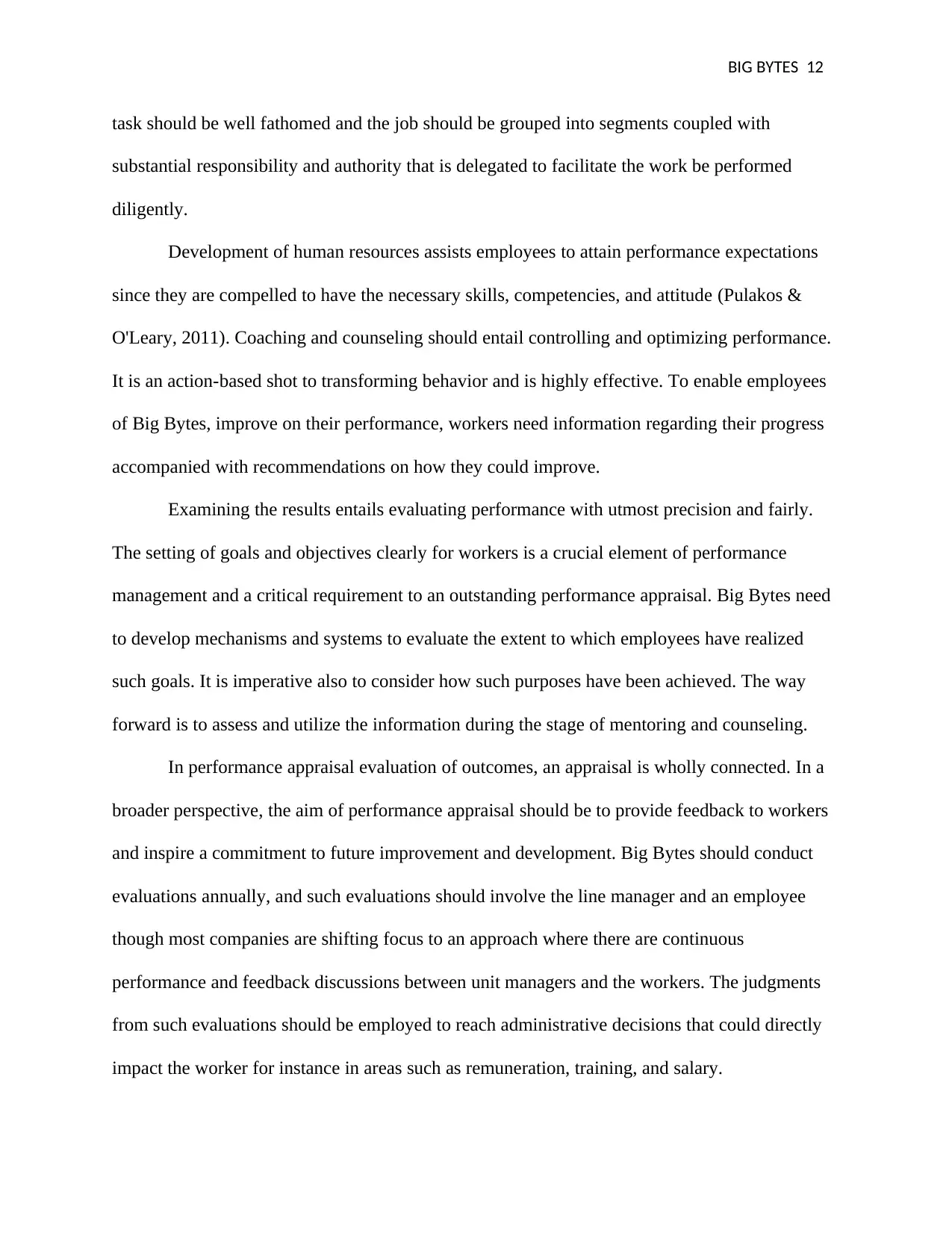
BIG BYTES 12
task should be well fathomed and the job should be grouped into segments coupled with
substantial responsibility and authority that is delegated to facilitate the work be performed
diligently.
Development of human resources assists employees to attain performance expectations
since they are compelled to have the necessary skills, competencies, and attitude (Pulakos &
O'Leary, 2011). Coaching and counseling should entail controlling and optimizing performance.
It is an action-based shot to transforming behavior and is highly effective. To enable employees
of Big Bytes, improve on their performance, workers need information regarding their progress
accompanied with recommendations on how they could improve.
Examining the results entails evaluating performance with utmost precision and fairly.
The setting of goals and objectives clearly for workers is a crucial element of performance
management and a critical requirement to an outstanding performance appraisal. Big Bytes need
to develop mechanisms and systems to evaluate the extent to which employees have realized
such goals. It is imperative also to consider how such purposes have been achieved. The way
forward is to assess and utilize the information during the stage of mentoring and counseling.
In performance appraisal evaluation of outcomes, an appraisal is wholly connected. In a
broader perspective, the aim of performance appraisal should be to provide feedback to workers
and inspire a commitment to future improvement and development. Big Bytes should conduct
evaluations annually, and such evaluations should involve the line manager and an employee
though most companies are shifting focus to an approach where there are continuous
performance and feedback discussions between unit managers and the workers. The judgments
from such evaluations should be employed to reach administrative decisions that could directly
impact the worker for instance in areas such as remuneration, training, and salary.
task should be well fathomed and the job should be grouped into segments coupled with
substantial responsibility and authority that is delegated to facilitate the work be performed
diligently.
Development of human resources assists employees to attain performance expectations
since they are compelled to have the necessary skills, competencies, and attitude (Pulakos &
O'Leary, 2011). Coaching and counseling should entail controlling and optimizing performance.
It is an action-based shot to transforming behavior and is highly effective. To enable employees
of Big Bytes, improve on their performance, workers need information regarding their progress
accompanied with recommendations on how they could improve.
Examining the results entails evaluating performance with utmost precision and fairly.
The setting of goals and objectives clearly for workers is a crucial element of performance
management and a critical requirement to an outstanding performance appraisal. Big Bytes need
to develop mechanisms and systems to evaluate the extent to which employees have realized
such goals. It is imperative also to consider how such purposes have been achieved. The way
forward is to assess and utilize the information during the stage of mentoring and counseling.
In performance appraisal evaluation of outcomes, an appraisal is wholly connected. In a
broader perspective, the aim of performance appraisal should be to provide feedback to workers
and inspire a commitment to future improvement and development. Big Bytes should conduct
evaluations annually, and such evaluations should involve the line manager and an employee
though most companies are shifting focus to an approach where there are continuous
performance and feedback discussions between unit managers and the workers. The judgments
from such evaluations should be employed to reach administrative decisions that could directly
impact the worker for instance in areas such as remuneration, training, and salary.
⊘ This is a preview!⊘
Do you want full access?
Subscribe today to unlock all pages.

Trusted by 1+ million students worldwide
1 out of 18
Related Documents
Your All-in-One AI-Powered Toolkit for Academic Success.
+13062052269
info@desklib.com
Available 24*7 on WhatsApp / Email
![[object Object]](/_next/static/media/star-bottom.7253800d.svg)
Unlock your academic potential
Copyright © 2020–2025 A2Z Services. All Rights Reserved. Developed and managed by ZUCOL.





